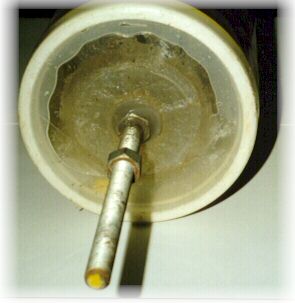Coil Sealing, At Home
This is an interesting project that was originally done by Ed Thomas, W5JXP, and it came about from a desire to keep his 160 meter mobile coils from being affected by weather when he was operating mobile. The end result was an encapsulation of the coils by shrinking 3-liter soft drink bottles around the coils. In Photo 1 (Above), the end result can be seen. As you can see, the coil was wound on a section of PVC. The wire size is #10 and the spacing was maintained by using weed eater cord. If you want to try this, do so at your own risk and use CLEAR plastic bottles. Two 3-liter bottles were used in this project It may be possible to use smaller bottles for smaller coils, which is an area of experimentation.
To start this project, after you have wound the coil and assembled it according to your particular requirements, take two 3-liter bottles that has been cleaned and then cut both ends out of them. Then slip one of the bottles over the coil form. Next, preheat your oven to 450-500 degrees Fahrenheit. Then stick your coil into the oven, close the door as much as you can. Spin the coil slowly and watch the bottle shrink around the coil. Be careful not to allow the coil or bottle to touch any part of the oven. That will cause both the plastic and PVC to melt with disastrous results. When the bottle has shrunk around the form to a snug fit, then remove the coil and allow it to cool. After the coil has cooled, then slip the second modified bottle over the other end of the coil and repeat the process.
Photo 2 below shows one end of the coil, and the machined plastic insert used as the end plate and support rod holder. This is also the connection point for that end of the coil. The end plate was sealed with RTV silastic on the inside of the plastic end piece which can be seen.

And Photo 3 shows the other end of the coil and the inner brass terminal that connects to the coil and then to the mounting rod. This is more visible than in the second photo above. The inner plastic backup and metal spacers can be seen as well as the outer shrunken bottle at the top of the photo.

I cannot say how all plastic bottles will behave when used as giant shrink tubing, but the excellent results of what Ed did can be seen here. It might be possible to achieve the same thing outside using a gas barbecue and a rotisserie to spin the coil, or other similar experiments. I would not recommend a torch because it involves too much direct heat and will cause uneven shrinkage. No matter which method you use, this will result in a very effective weatherproof coil. You will not be able to tap the coil and tuning will have to be done by some other means, such as a variable length top section of a mobile whip.
Originally posted on the AntennaX Online Magazine by Richard Morrow, K5CNF
Last Updated : 19th March 2024

